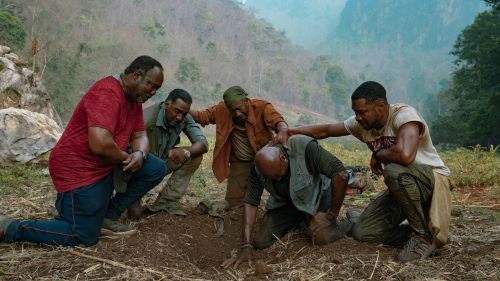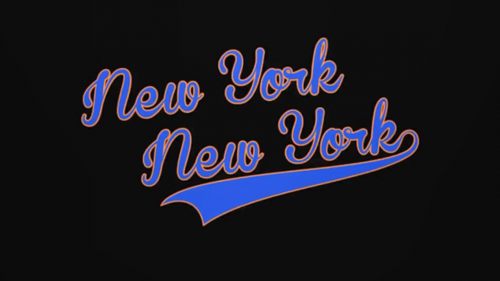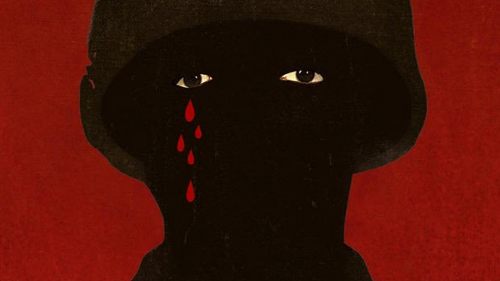Sunday Reads: Spike Lee & The Exploration Of Cinematic Racism In BLACKkKLANSMAN
BlacKkKlansman is in theaters now. Get your tickets here!
There's a moment during rookie detective Ron Stallworth's (John David Washington) first undercover operation where we hear how the cinematic image drastically affected one influential individual's worldview. Stallworth is sent by Chief Bridges (Robert John Burke) – head of the Colorado Springs Police Department – to covertly attend a rally being thrown by black subversive Stokely Carmichael. Upon arriving at the event organized by the Colorado College Black Student Union – a radical political group currently guided by President Patrice Dumas (Laura Harrier) – Stallworth learns that the speaker no longer goes by Carmichael, but has instead adopted the new name of Kwame Ture: a portmanteau of his African mentors’ monikers.
During one of the lengthier sequences in Spike Lee's BlacKkKlansman, we sit in on the speech delivered by a fiery, impassioned Ture (Corey Hawkins), as he urges the all-black crowd to value the color of their skin and define beauty through their own heritage. Ture illustrates his point through snapshots of his youth, when the leader would go to the movies every Saturday to catch the latest Tarzan picture. At these screenings, he'd cheer on a white Tarzan as the vine-swinging hero berated and abused the black "savages" – primitives who'd he'd beat back into their caves.
It wouldn't be until years later that Ture realized – whenever he clapped for the Caucasian King of the Jungle – he was essentially applauding his own people's brutalization at the hands of the white man. Ture's adult imagination then conjured up new versions of these films, where the natives revolted and sent Tarzan's "lilywhite ass back to Europe where he belongs". All the while, Lee juxtaposes the lecture against gorgeous tableaus of black faces; portrait-ready pictures of minds being molded in the moment by Ture’s rejection of pop cinema.
In this instance, Ture is conveying what it means to see one's self – or, in the case of Tarzan, a perversion of one's self – onscreen, and how those images can either support or injure one's own sense of identity. For a young Ture – who obviously hadn't yet taken up the Black Power movement – the fact that the only black actors in his favorite Tarzan movies were being forced to portray mindless caricatures was okay, because they were being presented as obstacles for his white “hero” to overcome. Yet once he revisited the movie with a more educated mind, it became clear to Ture that this was simply the way Hollywood viewed his black skin. In their eyes, he wasn't supposed to be the “hero”, and it enraged him. For all those years, he was being subliminally taught to fear and obey white supremacist masters, thanks to a silly piece of serialized pulp he gobbled up at matinees along with nickel popcorn and sodas as a boy.
So much of BlacKkKlansman – a genre movie that takes a recognizable storytelling mode (the "buddy cop" comedy) and remolds it to fit the revolutionary tale Lee is telling – deals with the cinematic image, and how it acts as a mirror: reflecting and distorting both American history and its people throughout the medium’s just over 100-year lifetime. There's a reason the very first scene we see in BlacKkKlansman wasn't even shot by Lee, but comes from Victor Fleming's heralded big screen adaptation of Gone With the Wind ('39). As the camera slowly pulls back over the battlefield of Atlanta, it's a reminder that one of the earliest American cinematic "classics" celebrated a white Southern heroine who owned slaves and even lived under a charred symbol of racist pride: The Confederate Flag (which fills up the majority of the first frame, defiantly flapping in the wind above hundreds of fallen Confederate soldiers).
Upon its release, Gone With the Wind was a national sensation, with its opening date even declared a state holiday by Eurith D. Rivers, the Governor of Georgia. The most expensive film production yet attempted by an ever-expanding Hollywood, producer David O. Selznick feared he’d never see a profit. Instead – despite a nearly four-hour running time – Gone With the Wind grossed 25 times its cost on the movie’s initial run, and won eight Academy Awards, including Best Picture. Adjusted for inflation, this Technicolor dream of the “Old South” – which comes complete with Hattie McDaniel's Best Supporting Actress win for her portrayal of house servant, Mammy – remains one of the biggest box office hits in US cinema history, and was named the fourth best American film by the AFI in ‘98.
Nevertheless, Gone With the Wind is still undeniably problematic, and has even been condemned by certain critics as being an antiquated relic that should go the way of the Confederate Flag. As Lou Lumenick wrote in the NY Post back in '15:
"True, Gone with the Wind isn’t as blatantly and virulently racist as D.W. Griffith’s Birth of a Nation, which was considered one of the greatest American movies as late as the early 1960s, but is now rarely screened, even in museums. The more subtle racism of Gone with the Wind is in some ways more insidious, going to great lengths to enshrine the myth that the Civil War wasn’t fought over slavery — an institution the film unabashedly romanticizes."
It's no coincidence D.W. Griffith's silent landmark is granted even more screen time in BlacKkKlansman than Gone With the Wind (which vanishes after the opening). Perhaps the original "blockbuster", Birth of a Nation ('15) struck such a resounding chord with the American public that President Woodrow Wilson reportedly remarked that watching the movie at a White House screening was like witnessing "history written with lightning". At the time of Birth’s release, the first iteration of the Ku Klux Klan – which inspired both Griffith (as well as the movie’s source text) and was arguably more of a white pride social club than the terrorist organization it eventually evolved into – was all but extinct. Yet some of the film's most objectionable scenes show the KKK riding to the rescue of a white family trapped in a cabin by sexually predatory blacks and their white manipulators, becoming a rallying cry for the organization's second, much more dangerous iteration.
Lee explores how Birth became a revivalist tool for racist whites rather vividly as Stallworth – with the aid of his Jewish "white half", Detective Philip 'Flip' Zimmerman (Adam Driver) – infiltrates the group and is even inducted as a member. At the membership ceremony, Zimmerman is anointed by Grand Wizard David Duke (Topher Grace) – who prefers the more politically savvy title "National Director" – before the Colorado chapter runs a 16mm print of Griffith's upsetting opus, hooting and hollering along with the aforementioned scenes that paint their tribe as nothing short of saviors. Just as Gone With the Wind glorified nefarious Southern views and traditions, its predecessor gifted these hideous forces of oppression moving images that allowed the Klan to see themselves as heroes of their own narrative, acting as the antithesis of what Tarzan did for Kwame Ture.
Being the superlative student of cinema that he is, Lee also allows Ron and Patrice a moment to reflect on the champions black people were given on the big screen during the '70s. While taking a walk together, they debate which of the era's Blaxploitation icons were the very best. Did Patrice favor Pam Grier in Coffy ('73) or Tamara Dobson in Cleopatra Jones ('73)? When it came to the big men of the Blax movement, who was more badass: Ron O'Neal's Superfly ('72) or Richard Roundtree's trenchcoated private detective Shaft ('71)? For Patrice, the choice is clear, as she's going to choose an investigator over a pimp eight days a week.
With a little help from the history books, the subtext of this scene becomes rather apparent (not to mention powerful). The works Spike’s chosen to represent how Southern pride was portrayed onscreen were gigantic mainstream hits, nominated for Oscars and celebrated for years by historians. Meanwhile, the Blaxploitation movement in '70s genre cinema was mostly financed outside of the studio system, usually by white producers who were looking to make a buck off inner city and drive-in audiences. Icons like Coffy and John Shaft were simply positive byproducts of capitalism; the Samuel Z. Arkoffs of the world employing maverick filmmakers to appeal to otherwise neglected audiences. But even when they were financed or distributed by major studios (as was the case with Shaft and Superfly), black audiences were forced to choose between pimps and private detectives as role models. Unless they were portrayed by Sidney Poitier, there weren't many other options.
Much has (rightfully) been made about the way in which Lee – during the last few minutes of the film – equates Colorado's Klansman to the current Trump administration. However, this cop movie has a much broader vision, and is looking far beyond the current political climate, hoping to diagnose how racism has been woven into the fabric of blockbuster culture since before Steven Spielberg and Jaws (’75) even solidified the word in our lexicon. By tackling this century-spanning historical issue and creating a visual dialogue, forcefully placing itself within the problematic lineage of pop pulp, Lee has ensured that BlacKkKlansman will endure well beyond its initial release. In a way, it’s as much a work of film criticism as it is a hilariously inciteful diversion, dissecting the subtle ways in which Hollywood has brainwashed us to believe that white is right, and that black should be kept to the margins of our entertainment landscape.
BlacKkKlansman is in theaters now. Get your tickets here!



